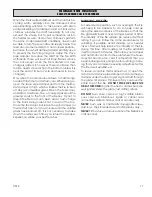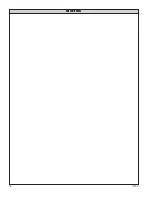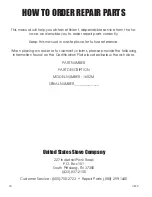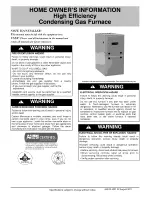
10
USSC
Do not over draft the furnace! It is designed to operate
at .06 inches of water column and must be set with a
draft gauge to maintain a steady draft. (Barometric
Damper recommended.)
Do not allow ashes to build up higher than 2” above
grates.
Never allow the ashes in the ash pan touch the grate
section.
REMOVE ASHES FREQUENTLY!
Be extremely careful when removing furnace ash pan;
it can get very hot.
With new steel, there is a small amount of oil or dirt on the
metal. You may smell an odor. This is normal during the
first operation. You may want to assemble the furnace
out of doors and build a small fire in it to “burn off” this
dirt and oil before installing the unit.
The furnace is designed to burn air dried wood and coal
at a predetermined firing rate. Over firing could result
in damage to the heat exchanger and cause danger
-
ous operation. Over firing occurs when the ash door is
left open during operation or a highly volatile fuel, i.e.
large amounts of small kindling, is used. If any portion of
the connector pipe glows orange or red, you are in an
over-firing situation. Close all dampers.
When tending the firebox always pull the baffle slide rod
out prior to opening load door. Open load door slowly
to avoid a “flash back”. After closing load door, push
the baffle slide rod to the rear.
Equip your home with fire extinguishers and smoke de
-
tectors appropriately located.
Inspect air filters regularly. The air filter in the filter box
should be changed at least every 30 days.
Oil motor on forced air draft every 90 days with a few
drops of 30 wt. oil.
The distribution blower motors may be one of two types.
If the motor has sealed bearings, no oiling is required.
If the motor is equipped with fill holes, the motor should
be oiled every 90 days with several drops of 30 wt. oil.
Check the fit on the load door. It must fit tightly. If it does
not, check for deterioration or wear of the ceramic rope
seal. Replace defective seals.
Inspect and clean your chimney and stove pipe regularly.
In event of chimney fire, shut all draft controls and call
your fire department immediately. Alert everyone in the
house. If the fire is still burning vigorously, throw baking
soda into firebox or discharge a fire extinguisher into the
firebox. After chimney fire is over, completely inspect
system for damage before further use.
NEVER
throw water on the fire or at the furnace, as rapidly
expanding steam could result in a severe scalding.
Slow fires: It is not recommended burning the Clayton
furnace any more than necessary early in the fall and
late spring, as you cannot keep the firebox hot enough
(without overheating your home) to burn gases. Slow
fires can cause excessive creosote build-up in smoke
pipe, chimney and firebox.
Wood should be placed directly onto the cast iron shaker
grate of the Clayton furnace. Do not use additional
grates and/or irons.
In the event of a power failure, you may operate the
furnace, provided the following instructions are followed:
1. Any air filter should be removed.
2. Observe the furnace operation closely and often till
power is restored.
Do not burn garbage, plastics, gasoline, drain oil or
other flammable liquids. Plastics, when burned, form
hydrofluoric and hydrochloric acids which will dam
-
age and destroy your furnace pipe and chimney. The
burning of trash or oil can result in an extremely hot fire
and is sometimes a cause of chimney fires.
NEVER BURN
GREEN WOOD OR TIRES.
Do not store fuel or other combustible material within
marked installation clearances.
NOTE: For further information on using your furnace safely,
obtain a copy of the National Fire Protection Association
publication “Using Coal and Wood Stoves Safely.” NFPA
NO. NW-8-1974. The address of the NFPA is 470 Atlantic
Ave., Boston, Massachusetts 02210.
OPERATING NOTES
THIS IS A WOOD AND COAL BURN-
ING FURNACE AND SHOULD NOT BE
ALTERED IN ANY WAY! DOING SO
WILL VOID YOUR WARRANTY!
If the fire goes out or does not hold overnight, look for:
1. Poor draft.
2. Incorrect damper settings.
3. Improper firing methods for coal being used.
4. More combustion air needed.
5. Coal not sized to the furnace. We recommend 1” to
3” diameter pieces of coal.
6. Ashes, if allowed to accumulate in the ash pit, will
not allow the passage of required air for combustion.
Keep ash pit clean.
7. This furnace is not to be used with an automatic stoker
unless so certified.
There are ONLY two types of coal allowed for use in this
furnace: Bituminous Coal
(soft coal)
and Anthracite
Coal
(hard coal)
.
NEVER USE
Cannel (or Channel) coal
or Brown (Lignite) Coal.
See our Bulletin RC454 at the rear of this manual for the
best information available on burning coal.
Содержание NITED STATES STOV 1602M
Страница 18: ...18 USSC NOTES ...
Страница 19: ...19 USSC NOTES ...

































